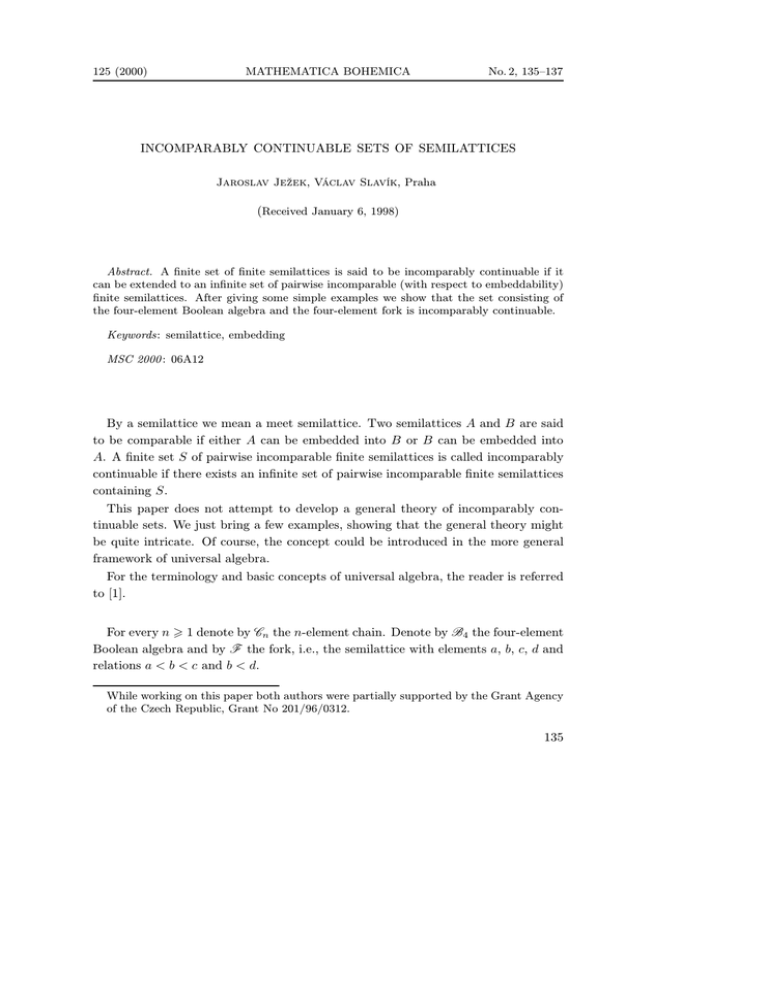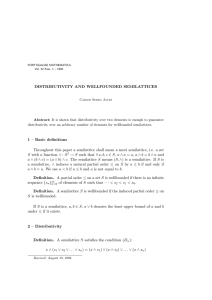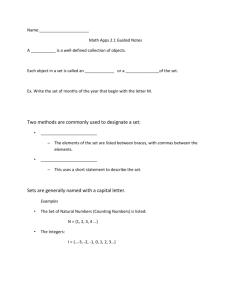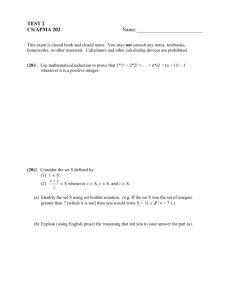INCOMPARABLY CONTINUABLE SETS OF SEMILATTICES (
advertisement

125 (2000)
MATHEMATICA BOHEMICA
No. 2, 135–137
INCOMPARABLY CONTINUABLE SETS OF SEMILATTICES
Jaroslav Ježek, Václav Slavík, Praha
(Received January 6, 1998)
Abstract. A finite set of finite semilattices is said to be incomparably continuable if it
can be extended to an infinite set of pairwise incomparable (with respect to embeddability)
finite semilattices. After giving some simple examples we show that the set consisting of
the four-element Boolean algebra and the four-element fork is incomparably continuable.
Keywords: semilattice, embedding
MSC 2000 : 06A12
By a semilattice we mean a meet semilattice. Two semilattices A and B are said
to be comparable if either A can be embedded into B or B can be embedded into
A. A finite set S of pairwise incomparable finite semilattices is called incomparably
continuable if there exists an infinite set of pairwise incomparable finite semilattices
containing S.
This paper does not attempt to develop a general theory of incomparably continuable sets. We just bring a few examples, showing that the general theory might
be quite intricate. Of course, the concept could be introduced in the more general
framework of universal algebra.
For the terminology and basic concepts of universal algebra, the reader is referred
to [1].
For every n 1 denote by Cn the n-element chain. Denote by B4 the four-element
Boolean algebra and by F the fork, i.e., the semilattice with elements a, b, c, d and
relations a < b < c and b < d.
While working on this paper both authors were partially supported by the Grant Agency
of the Czech Republic, Grant No 201/96/0312.
135
Theorem 1. If n 3, then {Cn } is not incomparably continuable. If n 4,
then {Cn } is incomparably continuable.
.
Every semilattice incomparable with C3 consists of the zero element
and a set of atoms. Any two such semilattices are comparable. Consequently, {C3 }
is not incomparably continuable.
For every n 3 let Sn be the semilattice with elements 0, a1 , . . . , an , b1 , . . . , bn
such that 0 < ai < bi for all i, ai < bi+1 for i < n, an < b1 (and there are no other
relations x < y). Then {C4 , S3 , S4 , S5 , . . .} is an infinite set of pairwise incomparable
finite semilattices.
Lemma 2. Let f0 , f1 , . . . be an infinite sequence of non-increasing functions from
n (where n ∈ ω is fixed). Then there exists an increasing sequence i0 < i1 < i2 < . . .
of nonnegative integers with fi0 fi1 . . ..
ω
.
By induction on n. For n = 0 it is clear. Let n > 0.
Suppose first that for some k 0, there are infinitely many numbers i with
fi (j) < n − 1 for all j k. Then for some k 0, there are infinitely many numbers
i with fi (j) = n − 1 for j < k and fi (j) < n − 1 for j k. Evidently, we can use
induction.
Now suppose that there is no such k. Then there is an infinite increasing sequence
j0 < j1 < j2 < . . . such that whenever fjl (i) = n − 1 then fjl+1 (i) = n − 1. We can
assume jl = l, and hence: whenever fl (i) = n−1 then fl+1 (i) = fl+2 (i) = . . . = n−1.
Define gk by gk (i) = fk (i) if fk (i) < n − 1 and gk (i) = n − 2 if fk (i) = n − 1. By
induction, there is an infinite sequence k0 < k1 < k2 < . . . with gk0 gk1 gk2 . . ..
But then evidently fk0 fk1 fk2 . . ..
Lemma 3. Let a0 , a1 , . . . be an infinite sequence of nonnegative integers. Then
there is a sequence i0 < i1 < i2 < . . . such that ai0 ai1 ai2 . . ..
.
If for every k there is an i with ai k, it is evident. In the opposite
case there is a number k with ai k for all i. Then there is a number k with ai = k
for infinitely many numbers i and everything is evident.
Lemma 4. Let f0 , f1 , f2 , . . . be an infinite sequence of non-increasing functions
from ω n (where n ∈ ω is fixed). Then there exists an infinite sequence i0 < i1 <
i2 < . . . with fi0 fi1 fi2 . . ..
.
By induction on n. For n = 0 it is evident. Let n > 0. By induction,
there is a sequence j0 < j1 < . . . such that fj0 n−1 fj1 n−1 fj2 n−1 . . ..
By Lemma 3 there is a sequence k0 < k1 < k2 < . . . such that fjk0 (n − 1) fjk1 (n − 1) fjk2 (n − 1) . . .. Then evidently fjk0 fjk1 fjk2 . . ..
136
Lemma 5. Let f0 , f1 , f2 , . . . be an infinite sequence of non-increasing functions
from ω ω . Then there exist i, j with i = j and fi fj .
. Suppose that there are no such i, j. Denote by m the minimum of all
fi (j). Let us fix a pair c, d with fc (d) = m. For every i = c there exists a number
j with fi (j) < fc (j); necessarily, j < d. Hence there is a number j0 < d such that
fi (j0 ) < fc (j0 ) for infinitely many numbers i. It follows from Lemma 2 that there
is a sequence k0 < k1 < k2 < . . . such that fk0 (ω − j0 ) fk0 (ω − j0 ) fk2 (ω − j0 ) . . .. It follows from Lemma 4 that there is a sequence l0 < l1 < l2 < . . .
such that fkl0 j0 fkl1 j0 fkl2 j0 . . .. Now, fkl0 fkl1 and kl0 = kl1 .
Theorem 6. The set {F , B4 } is not incomparably continuable.
.
Suppose that there is an infinite sequence F , B4 , A1 , A2 , . . . of pairwise
incomparable finite semilattices. For every nonincreasing sequence f from ω ω which
is non-zero on only a finite subset of ω define a finite semilattice Sf with zero 0 and
elements 0 < a0,1 < . . . < a0,f (0) , 0 < a1,1 < . . . < a1,f (1) , . . ., 0 < ak,1 < . . . <
ak,f (k) where k is the greatest number with f (k) = 0. Then every Ai is some Sf .
Since Sf is embeddable into Sg if f g, the result follows from Lemma 5.
It would be possible to formulate various open problems concerning incomparably
continuable sets of semilattices (or other kinds of algebraic systems). Let us point
out just one open problem:
. Is there an algorithm deciding, for any finite set of finite semilattices,
whether the set is incomparably continuable?
References
[1] R. McKenzie, G. McNulty, W. Taylor: Algebras, Lattices, Varieties, Vol. I. Wadsworth
& Brooks/Cole, Monterey, CA, 1987.
Authors’ addresses: Jaroslav Ježek, Charles University, Sokolovská 83, 186 75 Praha 8,
Czech Republic, e-mail: jezek@karlin.mff.cuni.cz; Václav Slavík, Czech Agricultural University, Kamýcká 129, 165 21 Praha 6, Czech Republic, e-mail: slavik@tf.czu.cz.
137








